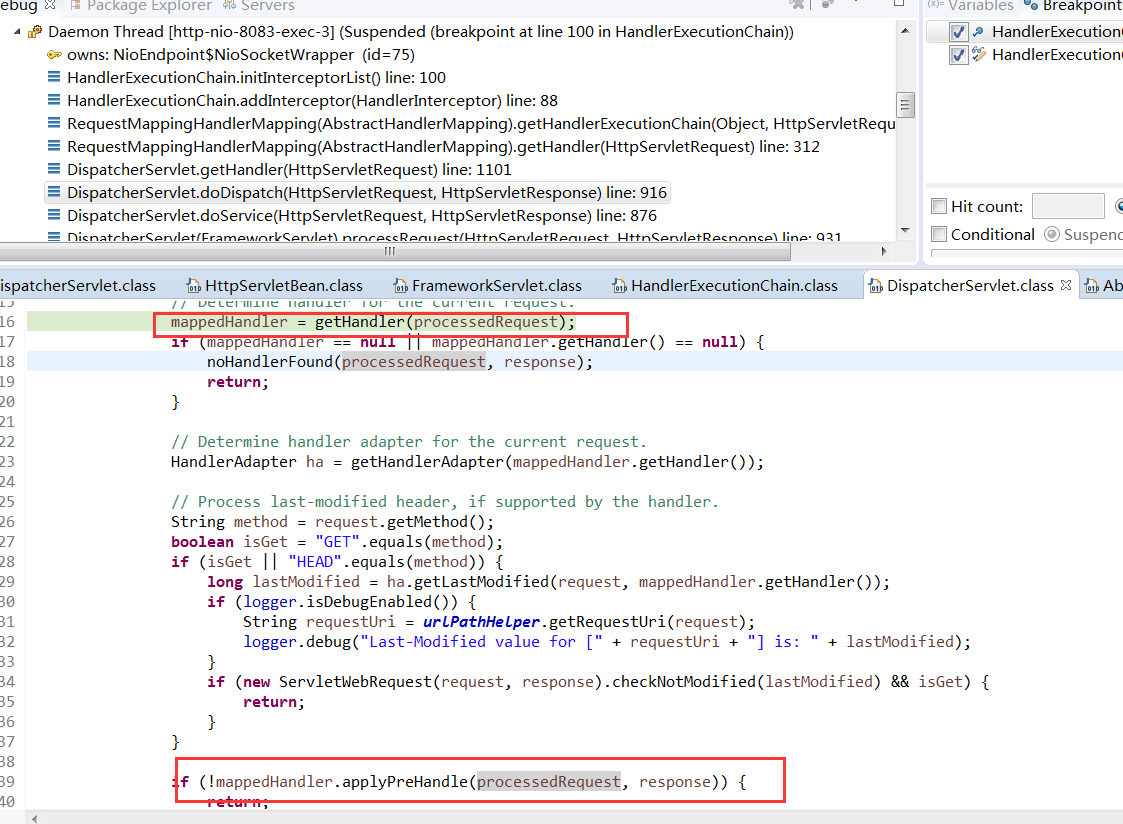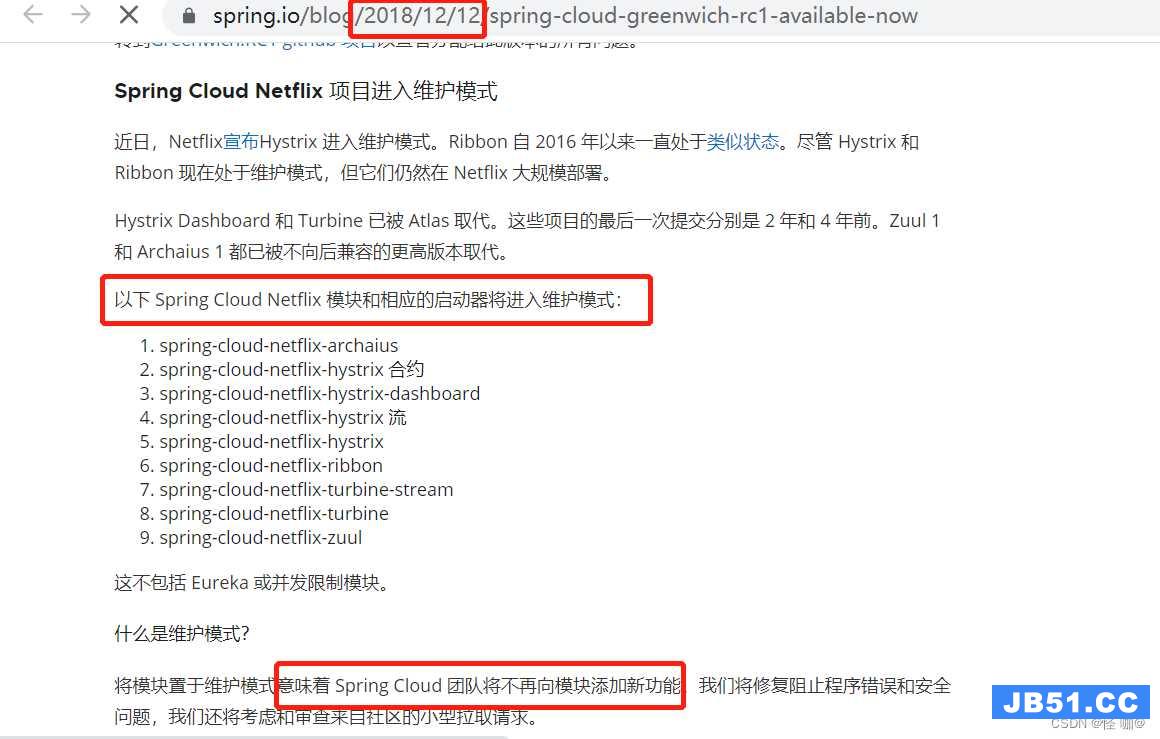首先,先简单的说一下怎么配置SpringMvc的拦截器。
分两步,第一步先定义一个类,实现HandlerInterceptor接口。
import javax.servlet.http.HttpServletRequest; javax.servlet.http.HttpServletResponse; org.springframework.web.servlet.HandlerInterceptor; org.springframework.web.servlet.ModelAndView; public class TestInterceptor implements HandlerInterceptor{ @Override boolean preHandle(HttpServletRequest request,HttpServletResponse response,Object handler) throws Exception { System.out.println("preHandle invoke"); return true; } @Override void postHandle(HttpServletRequest request,Object handler,ModelAndView modelAndView) Exception { System.out.println("postHandle invoke"); } @Override afterCompletion(HttpServletRequest request,Exception ex) Exception { System.out.println("afterCompletion invoke"); } }
第二布,配置springMvc.xml
<!-- 拦截器 --> <mvc:interceptors> mvc:interceptor> mvc:mapping path="/*"/> bean class="com.mmc.interceptor.TestInterceptor"></bean</> >
完工。下面分析原理
打开这个DispatcherServlet类,这个类是SpringMvc中最核心的一个类。答案就在doDispatch方法里面:
protected void doDispatch(HttpServletRequest request,HttpServletResponse response) Exception { HttpServletRequest processedRequest = request; HandlerExecutionChain mappedHandler = null; boolean multipartRequestParsed = false; WebAsyncManager asyncManager = WebAsyncUtils.getAsyncManager(request); try { ModelAndView mv = ; Exception dispatchException = ; { processedRequest = checkMultipart(request); multipartRequestParsed = processedRequest != request; // Determine handler for the current request. mappedHandler = getHandler(processedRequest); if (mappedHandler == null || mappedHandler.getHandler() == ) { noHandlerFound(processedRequest,response); return; } Determine handler adapter for the current request. HandlerAdapter ha = getHandlerAdapter(mappedHandler.getHandler()); Process last-modified header,if supported by the handler. String method = request.getMethod(); boolean isGet = "GET".equals(method); if (isGet || "HEAD".equals(method)) { long lastModified = ha.getLastModified(request,mappedHandler.getHandler()); if (logger.isDebugEnabled()) { String requestUri = urlPathHelper.getRequestUri(request); logger.debug("Last-Modified value for [" + requestUri + "] is: " + lastModified); } if (new ServletWebRequest(request,response).checkNotModified(lastModified) && isGet) { ; } } if (!mappedHandler.applyPreHandle(processedRequest,response)) { return; } { Actually invoke the handler. mv = ha.handle(processedRequest,response,mappedHandler.getHandler()); } finally (asyncManager.isConcurrentHandlingStarted()) { ; } } applyDefaultViewName(request,mv); mappedHandler.applyPostHandle(processedRequest,mv); } catch (Exception ex) { dispatchException = ex; } processDispatchResult(processedRequest,mappedHandler,mv,dispatchException); } (Exception ex) { triggerAfterCompletion(processedRequest,ex); } (Error err) { triggerAfterCompletionWithError(processedRequest,err); } { (asyncManager.isConcurrentHandlingStarted()) { Instead of postHandle and afterCompletion mappedHandler.applyAfterConcurrentHandlingStarted(processedRequest,response); ; } Clean up any resources used by a multipart request. (multipartRequestParsed) { cleanupMultipart(processedRequest); } } }
里面我标红了四处,第一处对应执行自定义拦截器的preHandler方法,第二处对应执行你的Controller类中的RequestMapping映射的处理方法,第三处是自定义拦截器的postHandle方法,第四处是自定义拦截器的afterCompletion方法。
这些可能很多人都知道,但是我们肯定还有疑问,为什么他能调用到我的拦截器里写的方法呢?
接着往下分析。
于是我们点开我第一处标红那里的mappedHandler.applyPreHandle方法。代码如下:
boolean applyPreHandle(HttpServletRequest request,1)"> Exception { if (getInterceptors() != ) { for (int i = 0; i < getInterceptors().length; i++) { HandlerInterceptor interceptor = getInterceptors()[i]; if (!interceptor.preHandle(request,this.handler)) { triggerAfterCompletion(request,); ; } this.interceptorIndex = i; } } ; }
看得出来,他是在遍历getInterceptors(),所以在点开这个方法。

public HandlerInterceptor[] getInterceptors() { this.interceptors == null && this.interceptorList != this.interceptors = this.interceptorList.toArray(new HandlerInterceptor[.interceptorList.size()]); } .interceptors; }
这里面有两个变量,interceptorList和interceptors。这时我肯定会猜想,肯定是某个时候系统框架把这两个变量赋值了,然后在我执行方法的时候都会去看看这两个变量是不是有值的。有就执行拦截器。
那么这两个变量是什么时候赋值的呢?找到定义这两个变量的地方,他们是在HandlerExecutionChain类里面,我把断点打在这个变量定义那里。debug运行,代码停在了HandlerExecutionChain里面

看debug模式中的方法执行顺序,点到doDispatch方法里面,在执行applyPreHandle即调用拦截器的方法之前,有一个getHandler方法,这个方法里面有getHandlerExecutionChain方法。这个方法里面有如下代码:
protected HandlerExecutionChain getHandlerExecutionChain(Object handler,HttpServletRequest request) { HandlerExecutionChain chain = (handler instanceof HandlerExecutionChain) ? (HandlerExecutionChain) handler : new HandlerExecutionChain(handler); chain.addInterceptors(getAdaptedInterceptors()); String lookupPath = urlPathHelper.getLookupPathForRequest(request); for (MappedInterceptor mappedInterceptor : mappedInterceptors) { (mappedInterceptor.matches(lookupPath,pathMatcher)) { chain.addInterceptor(mappedInterceptor.getInterceptor()); } } chain; }
注意看,里面有一句chain.addInterceptor(mappedInterceptor.getInterceptor());这个从名字就知道是添加拦截器。而这个拦截器是从mappedInterceptor获得的属性,mappedInterceptor是遍历mappedInterceptors得到的。而这个对象在我运行这个的时候就已经存在了。所以我思考是不是启动项目的时候就已经初始化了,而且是根据我的xml配置文件来初始化的。于是我在mappedInterceptors对象处打断点,启动tomcat。果然代码执行到了。在AbstractHandlerMapping类中找到了这个方法,
@Override void initApplicationContext() BeansException { extendInterceptors(.interceptors); detectMappedInterceptors(.mappedInterceptors); initInterceptors();
在这个detectMappedInterceptors(this.mappedInterceptors);里面便是将mappedInterceptors对象赋值了。下面我就不贴代码了。就是去找MappedInterceptor类,这个类是根据xml文件中<mvc:interceptor>的内容来构建的。构建方法在InterceptorsBeanDefinitionParser类里面。
顺着来一遍就是这样的:
启动项目,InterceptorsBeanDefinitionParser类会根据配置文件构建MappedInterceptor对象集合,当我发送请求的时候,系统去看这个集合里有没有值,如果有值,就遍历执行这个对象,取得这个对象中的HandlerInterceptor属性,也就是我自定义的拦截器的对象。然后去执行我这个拦截器中的三个方法。到此拦截器的运行原理就分析完了。
有分析不对的地方请不吝指出


 这篇文章主要介绍了SpringCloudAlibaba和SpringCloud有什么区...
这篇文章主要介绍了SpringCloudAlibaba和SpringCloud有什么区... 本篇文章和大家了解一下SpringCloud整合XXL-Job的几个步骤。...
本篇文章和大家了解一下SpringCloud整合XXL-Job的几个步骤。... 本篇文章和大家了解一下Spring延迟初始化会遇到什么问题。有...
本篇文章和大家了解一下Spring延迟初始化会遇到什么问题。有... 这篇文章主要介绍了怎么使用Spring提供的不同缓存注解实现缓...
这篇文章主要介绍了怎么使用Spring提供的不同缓存注解实现缓...